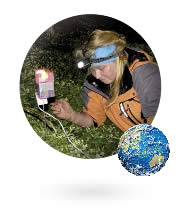
Jaimie Cleeland
Institute of Marine and Antarctic Studies
Tracking Short-tailed shearwaters
Short-tailed shearwaters or 'muttonbirds' depart from the northern Pacific Ocean and travel thousands of kilometres across open ocean to reach their breeding colonies in south east Australia in late September. They take up temporary residence on coastal dunes, offshore islands and other remote coastal areas to lay eggs and fledge their chicks. These birds fascinated me from a young age; I would stay on our local beach with my family for hours waiting for it to get dark enough to see the first bird arrive at night.
After completing a Bachelor of Science at Monash University in Victoria, I spent numerous weeks on remote offshore islands, such as Heron Island on the Great Barrier Reef and Kanowna Island in Bass Strait. Whilst I was on the islands I was watching birds and collecting data on their movement and behaviours for seabird conservation groups. I also had a stint working as a Penguin Parade Ranger, teaching people about the interesting life of Little Penguins! I then came to the University of Tasmania to do an Honours year at the Institute of Marine and Antarctic Studies.
 My honours project involved tagging short-tailed shearwaters to track their foraging flights over the Southern Ocean and Antarctic waters. To do this I camped out on a remote and isolated island for 70 days over the summer with a team of volunteer assistants. Whilst on the island, my volunteers and I had two main jobs. Firstly, we captured adults found within burrows and deployed geo-location tags to capture their movements throughout the breeding season. The second job was to measure the growth of chicks to determine how much food each chick required to fledge from the burrow. I found that individual shearwaters could travel over 10,000 km in a single feeding trip and most birds fed from cold and highly productive Antarctic waters. Additionally, I found that chicks required nearly 4kg of krill, squid or fish to fledge; which is equivalent to an adult human consuming over 7kg of food per day!
My honours project involved tagging short-tailed shearwaters to track their foraging flights over the Southern Ocean and Antarctic waters. To do this I camped out on a remote and isolated island for 70 days over the summer with a team of volunteer assistants. Whilst on the island, my volunteers and I had two main jobs. Firstly, we captured adults found within burrows and deployed geo-location tags to capture their movements throughout the breeding season. The second job was to measure the growth of chicks to determine how much food each chick required to fledge from the burrow. I found that individual shearwaters could travel over 10,000 km in a single feeding trip and most birds fed from cold and highly productive Antarctic waters. Additionally, I found that chicks required nearly 4kg of krill, squid or fish to fledge; which is equivalent to an adult human consuming over 7kg of food per day!
Shearwaters are known as marine predators as they prey on other animals in marine ecosystems. Understanding where these marine predators feed is crucial to understanding aspects of the whole marine environment and how we can best conserve it.
As a student researcher at the Institute of Marine and Antarctic Studies, I have been given opportunities to work in amazing places with some amazing animals. It's very rewarding knowing that the Honours project I have completed will contribute significantly to what we already know about top predators in the Southern Ocean.
Find out more about Short Tailed Shearwaters visit https://www.parks.tas.gov.au/index.aspx?base=5100
